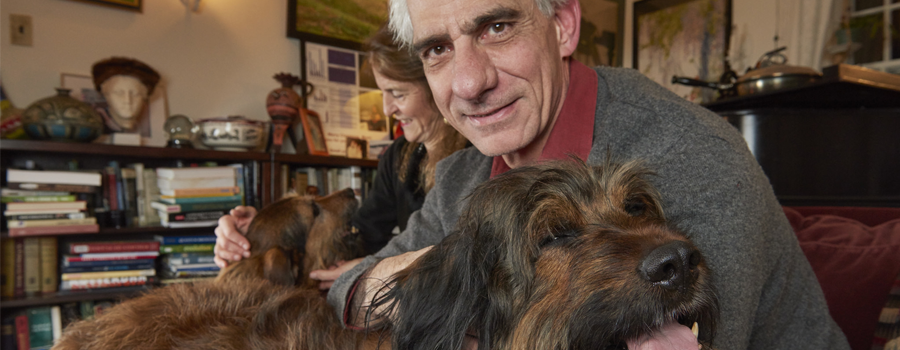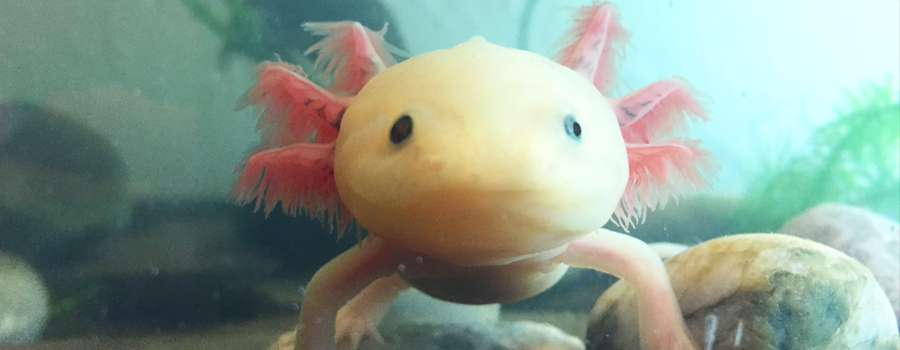
Credit: Peggy Peterson for Penn Medicine magazine
They say a dog is man’s best friend. But if that man (or woman) is a researcher? It might not be just any regular dog.
Meet Venus and Mercury, a 10-year-old female and 8-year-old male Swedish Briard dog. This mother-and-pup pair are the loving companions of married-couple researchers Jean Bennett, MD, PhD, and Albert Maguire, MD. But before they found their happy home, like many Swedish Briards, they were born with a form of congenital blindness that is genetically identical to the human progressive disease called Leber’s congenital amaurosis (LCA). Like humans with LCA, Venus and Mercury were born with impaired eyesight that got progressively worse with age — until they underwent an experimental therapy that Bennett and Maguire had pioneered.
Their vision now is not perfect, but it is vastly improved. Testing the therapy in dogs was essential to get enough data on safety and effectiveness to proceed with human trials. Those trials were so successful that the therapy Venus and Mercury helped test has now become the first gene therapy to be approved by the Food and Drug Administration to treat a genetic disease (in humans). And soon after these sweet dogs finished their service to science, Bennett and Maguire insisted on taking them home for a life of snuggles, runs in the country, and very awkward lap-sitting.

Background: Bennett with Venus. Foreground: Maguire with Mercury. Credit: Peggy Peterson for Penn Medicine magazine
“Once the dog licked my face, wagging its tail—you’re done with, it’s over,” Maguire said, as reported in a feature article about the couple’s life, work, and dog-adoption journey, that will run in the forthcoming Winter 2018 issue of Penn Medicine magazine. (You’ll want to see this story — lots more dog photos to come!)
These loving dogs just might be the most in-your-face and fluffy adorable pets that come from the realm of scientific study, but they aren’t the only ones. A number of other researchers aren’t necessarily taking their own study subjects home with them but are adopting pets that are in some way inspired by their interests in biomedical science.
Consider the axolotl.

Glompner the axolotl. Credit: Ben Tajer
Axolotls are very smiley salamanders with feathery gills, and they are more than just adorable. They are also spectacularly good at regenerating and therefore hold biological secrets that could be valuable to science. At a recent student-run journal club for graduate students in Developmental, Stem Cell and Regenerative Biology at the Perelman School of Medicine, one of the graduate students from the Mullins lab brought in a paper about research on axolotls. She had studied them in a lab as an undergraduate.
“That started the conversation,” recalled Ben Tajer, also a graduate student in the Mullins lab. “That’s when I realized how much people liked them.”
Before too long, and by a bit of luck, Tajer became Penn’s go-to expert axolotl hobbyist. He had enjoyed raising newts and salamanders, including axolotls, since childhood but had taken a break from having pets during grad school. He always enjoyed them, though, “because they’re little prehistoric animals that go through this cool metamorphosis and you can see them walking around on the bottom of the tank.” At grad school, he didn’t have a tank — until he found a large one, by chance, abandoned near Clark Park in West Philadelphia. Once he had the tank and the inspiration, he ordered 50 axolotl eggs, some to give away, a few to raise and keep, and some to raise and give away to friends.
Axolotl fever soon took over among a number of graduate students at Penn. With his 50 eggs, Tajer had accounted for a fair number of the baby axolotls to cannibalize each other as they grew up (a common risk in this carnivorous species), but that didn’t happen. Most of the babies survived and are alive and thriving in tanks of Penn graduate students. Eight students in Cell and Molecular Biology are currently raising axolotls. Tajer still has six of his own. As a scientist, Tajer enjoys the fact that axolotls are a scientifically interesting species. But he suspects the appeal is much simpler for most of his friends.
“I think mostly people like them because they’re cute,” he said. “I never thought of them as cute until I realized how much everyone else did.”
You can read much more about Tajer and other Penn graduate students’ axolotls, and about axolotls themselves, over on the Cell and Molecular Biology student newsletter.
It turns out, once you start looking, researchers adopting pets that are similar to their study species happens more than you’d think. The head of the lab where Tajer is training,
Mary Mullins, PhD, a professor and vice chair of Cell and Developmental Biology, keeps zebrafish in a home aquarium. Zebrafish are both a popular home aquarium fish and an
important model organism (especially in their embryonic and larval form) for understanding the biology of how cells and tissues grow and differentiate in vertebrate animals, as well as for
understanding neuroscience and behavior. Keeping them as a pet was a practical family choice for Mullins and her husband, fellow Cell and Developmental Biology Professor and
zebrafish researcher Michael Granato, PhD.
“Our kids wanted a pet, so we decided on zebrafish because we knew how to take care of them already,” Mullins said. “We enjoyed decorating the tank with the typical aquarium décor and satisfied the pet desire of the kids.”
Then there’s Karl Glastad, PhD, a postdoctoral researcher in the lab of Shelley Berger, PhD, who was previously profiled on this blog for his work with ants — in the lab studying epigenetics, and in his personal life. Glastad still keeps “pet” ants at home. But he notes that they are different species than the ones he studies in the lab. For one thing, research regulations would make it difficult to take any actual study animals or their offspring home. But he does have small numbers of several different species, Pogonomyrmex barbatus, Camponotus tortuganus, and a species of Formica.
“There are a few other species I'd definitely keep if I could get my hands on them, but I just don’t have time to go on dedicated collecting trips to South America or even southern Texas these days,” Glastad said. He added that he really wants leafcutter ants, which are found in those parts of the world, but they’re tough to catch except at certain times of year.
There are worse ways to take work home with you.
Update: The story is now live—and includes even more adorable dog photos!